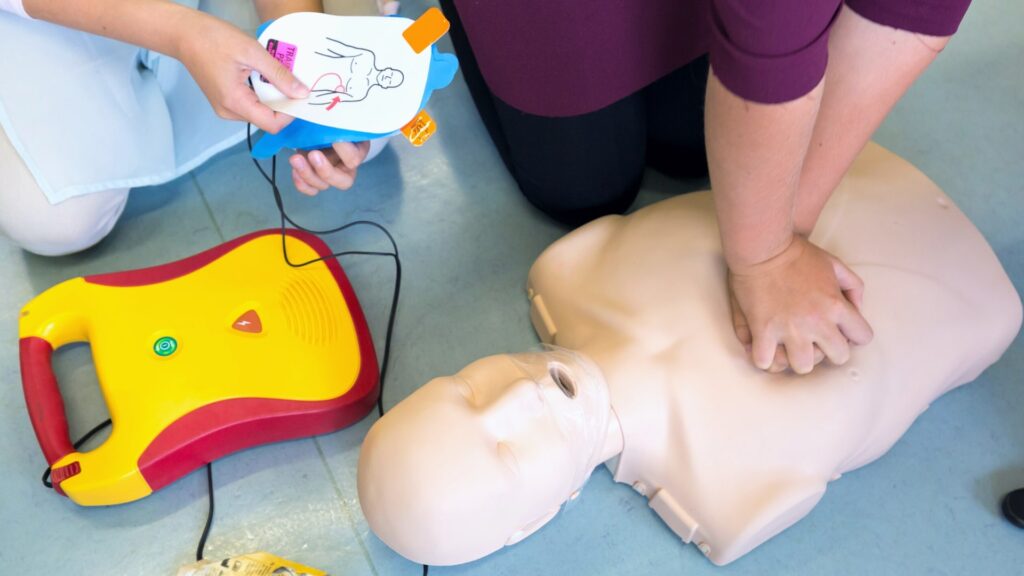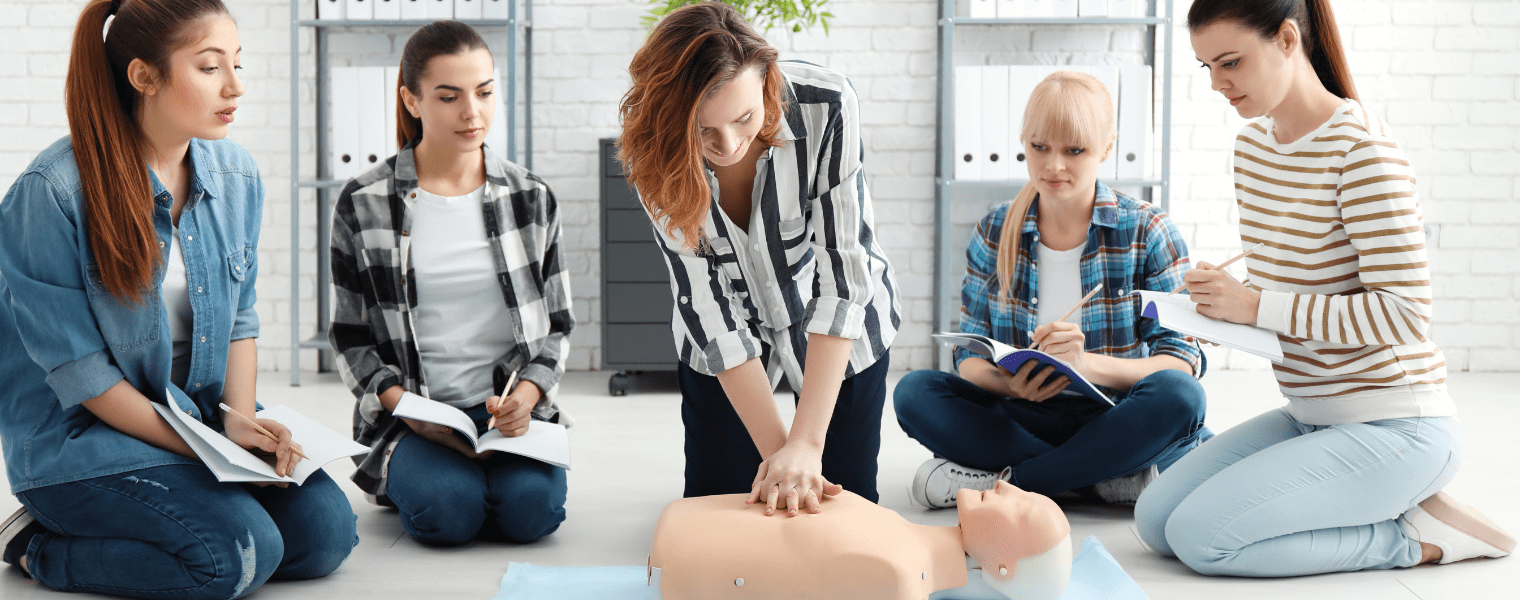Have you heard of an AED before? If you haven’t, we’re sure you’ve seen one! AEDs are typically seen in medical shows (such as Grey’s Anatomy). But most importantly, AEDs can be found in public spaces. If you’ve ever been to an airport, government building or train station, you may have noticed an AED in a box attached to the wall.
In this blog, we’ll discuss some commonly asked questions regarding the AED. A few of these questions include: what is an AED and when to use it?
What is an AED?
An AED, otherwise known as an automated external defibrillator, is an easy-to-use medical device found in most workspaces, schools, and public buildings. The sophisticated device can help you to analyze someone’s heart rhythm and notifies you if you must deliver an electrical shock to help restore their heartbeat.
Inquire about First Aid & CPR Training Course
Ready to learn how to use an AED? Inquire about one of our First Aid & CPR training courses! Training is available throughout Ontario.
When Do You Use an AED?
When a person suffers from unexpected cardiac arrest, you can use an AED to revive them. Any disruption in the heart’s electrical activity can cause ventricular tachycardia (a fast and dangerous heart beat) or ventricular fibrillation (an irregular heartbeat). These irregular heart rhythms keep the heart from pumping effectively and can cause it to cease beating.
With this event, the brain and other vital organs can’t get the required blood and oxygen. Unfortunately, unless the patient receives immediate help, death can occur within minutes, and an AED can help restore the heart’s rhythm to help prevent permanent damage.

Using an AED can deliver an electrical jolt required to get the heart back to its regular rhythm and save the person’s life.
By combining cardiopulmonary resuscitation (CPR) and the use of an AED, a person suffering from cardiac arrest has a better chance of survival. CPR can help keep blood flowing to the heart and brain, but defibrillation can help restore the heart’s beat.
How Do You Use an AED?
In a situation where a person is unconscious, you need to do the following:
- Check the person to see if they have a pulse and are breathing (check their ABCs).
- If you cannot detect a pulse or any signs of breathing, immediately call for emergency help. If someone else is with you, ask them to call 911 and get an AED.
- Begin CPR (30 compressions, 2 breaths) while you wait to receive the AED (review the steps).
- First, turn the AED on and follow the instructions it provides. The instructions will tell you how to check for breathing and pulse, whether on-screen or by voice. It will also guide you in positioning the electrode pads on the victim’s bare chest.
- When you remove any clothing covering the person’s chest, ensure that the area is dry; otherwise, wipe it down.
- Position one pad on the patient’s upper right side of their chest and the second one on the lower left side, a few centimeters below the armpit. In cases where the pads may touch, you can position one in the middle of the front chest and the other between the shoulder blades on the back.
- Ensure that the connector cable is plugged into the AED.
- When properly positioned, the AED will automatically measure the person’s heart rhythm and determines if you need to proceed with a shock. Remember that no one should be touching the person when a shock is being delivered. When prompted to shock, say “CLEAR” to anyone present to make sure everyone steps back.
- If needed, the machine will guide you on what to do. The first step is to stand back before you push the button for the AED to deliver the shock. AEDs are programmed not to provide a shock if it isn’t needed.
- After delivering the shock, you may still need to perform CPR on the person, and most AEDs take you through the correct steps. However, you may need to repeat the process until emergency rescuers arrive to take over.
- If the AED does not deliver a shock, or it advises that none is needed, begin compressions.
All AEDs come with instructions on how to use and maintain them. Anyone can buy an AED for their home or business, but you should read the instructions and review them often.

Do You Need an AED at Home?
All emergency rescuers and police carry AEDs to use in emergencies. Still, they are always available in most public places, including office buildings, malls, sports arenas, gyms, and even on airplanes.
However, cardiac arrests can also occur at home. An AED can help you revive a person with ventricular fibrillation or ventricular tachycardia, mainly if they fall in a high-risk category. If you know someone in your home who is more prone to cardiac arrest, having an AED may be a good idea!
Why You Need to Learn to Use an AED?
Strokes and cardiac arrests require immediate first aid that entails CPR or an AED to reduce the risk of permanent damage and death. Canadian authorities estimate that about 35,000 people have cardiac arrests annually, most of which occur at home—the survival rate of these people doubles when they have someone near them who can perform CPR and use an AED.
Currently, using an AED in combination with CPR is the best way to restore a victim’s regular heart rhythm during cardiac arrest. When faced with a cardiac arrest emergency, you should immediately call 911 and begin the steps required to keep them alive until emergency help arrives.
Remember, the odds of a patient’s survival decrease by 10% for every minute you delay defibrillation. Therefore, it is critical to have access to an AED and to know how to use it.
Why Get CPR/AED Certification?
CPR/AED certification is not only needed by first responders and medical personnel. By learning to manually circulate blood around the body with compressions and using an AED, you can administer the emergency procedure to someone in need at any time. Medical statistics indicate that 9 out of 10 people suffering cardiac arrest outside of a hospital don’t survive. With CPR, their chances of survival increase.
Therefore, CPR/AED training at any age gives you the lifesaving skills required to help others, making all the difference between whether a cardiac arrest or stroke victim lives or dies.

CPR/AED Training with Coast2Coast
Get your Red Cross CPR/AED certification or recertification from Coast2Coast to ensure you know how to apply these techniques to anyone that may need assistance during cardiac arrest. Whether you need Level A or Level C training, our courses are WSIB-approved and ensure you know exactly how to recognize and manage cardiac arrest correctly and without panic. Get the certification and self-confidence to help others by contacting one of our centers near you in the Greater Toronto Area, Eastern and Western Ontario.



















